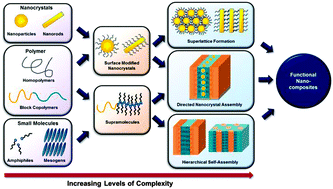Toward functional nanocomposites: taking the best of nanoparticles, polymers, and small molecules†
Abstract
Nanocomposites, composed of organic and inorganic building blocks, can combine the properties from the parent constituents and generate new properties to meet current and future demands in functional materials. Recent developments in nanoparticle synthesis provide a plethora of inorganic building blocks, building the foundation for constructing hybrid nanocomposites with unlimited possibilities. The properties of nanocomposite materials depend not only on those of individual building blocks but also on their spatial organization at different length scales. Block copolymers, which microphase separate into various nanostructures, have shown their potential for organizing inorganic nanoparticles in bulk/thin films. Block copolymer-based supramolecules further provide more versatile routes to control spatial arrangement of the nanoparticles over multiple length scales. This review provides an overview of recent efforts to control the hierarchical assemblies in block copolymer-based hybrid nanocomposites.

- This article is part of the themed collection: Chemistry of functional nanomaterials

 Please wait while we load your content...
Please wait while we load your content...